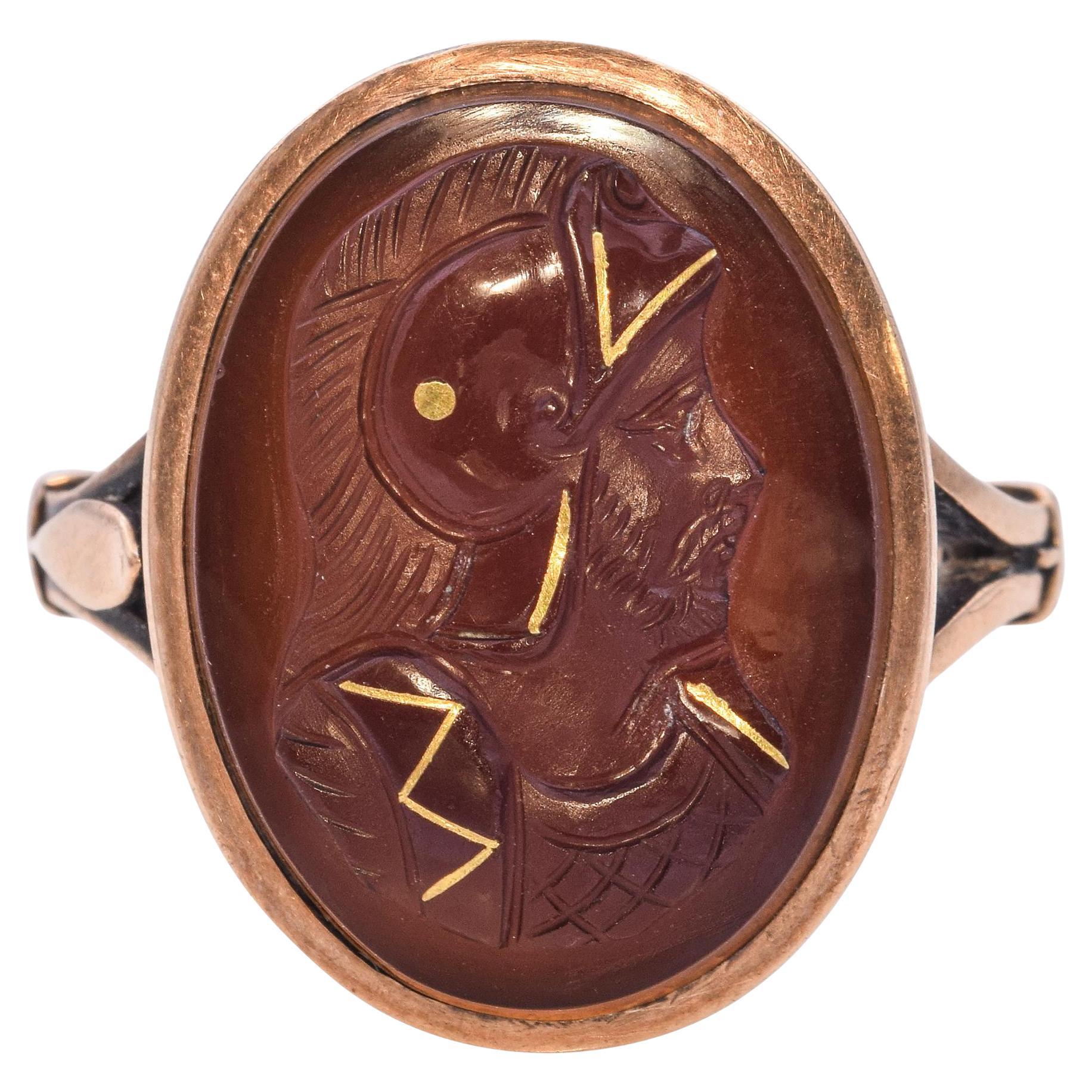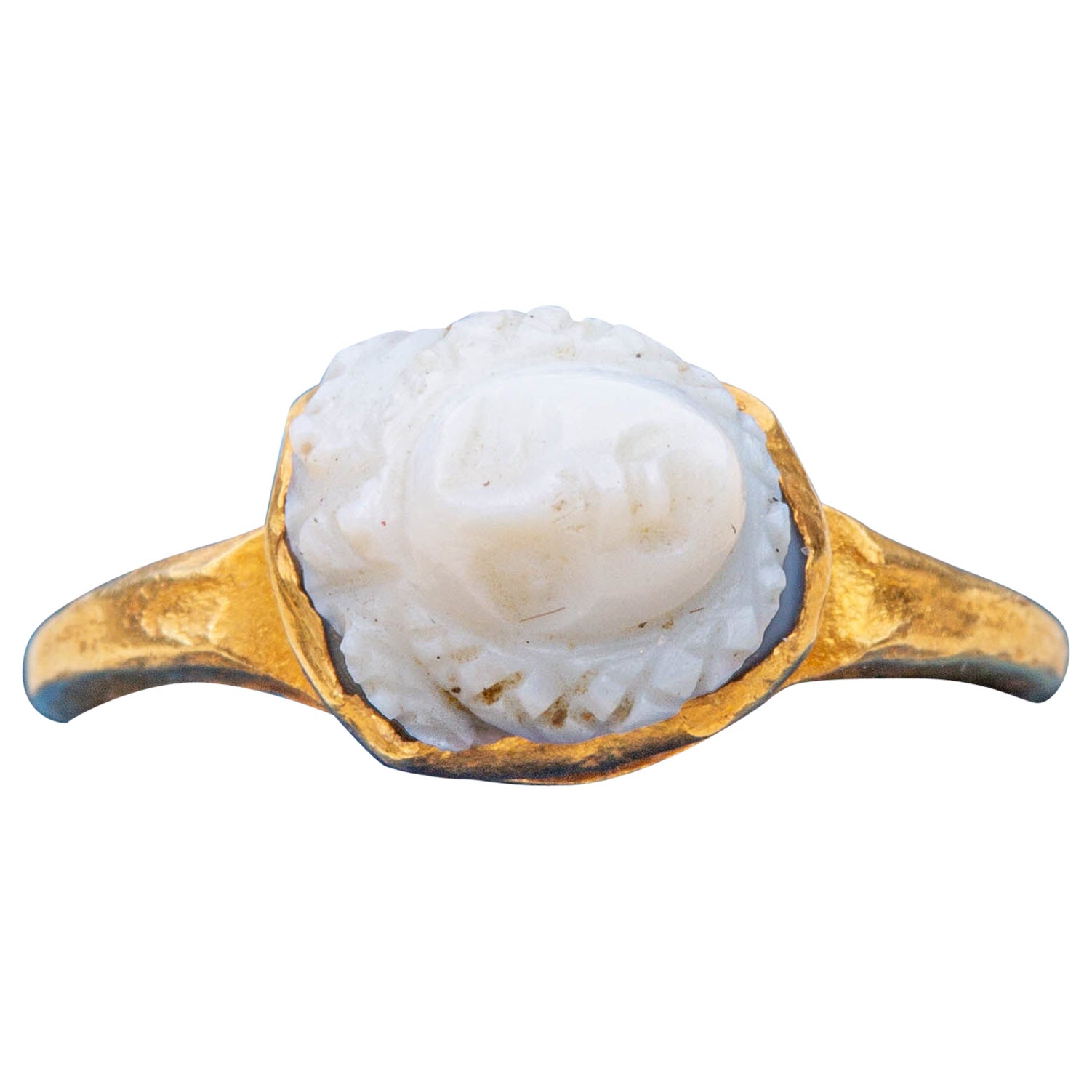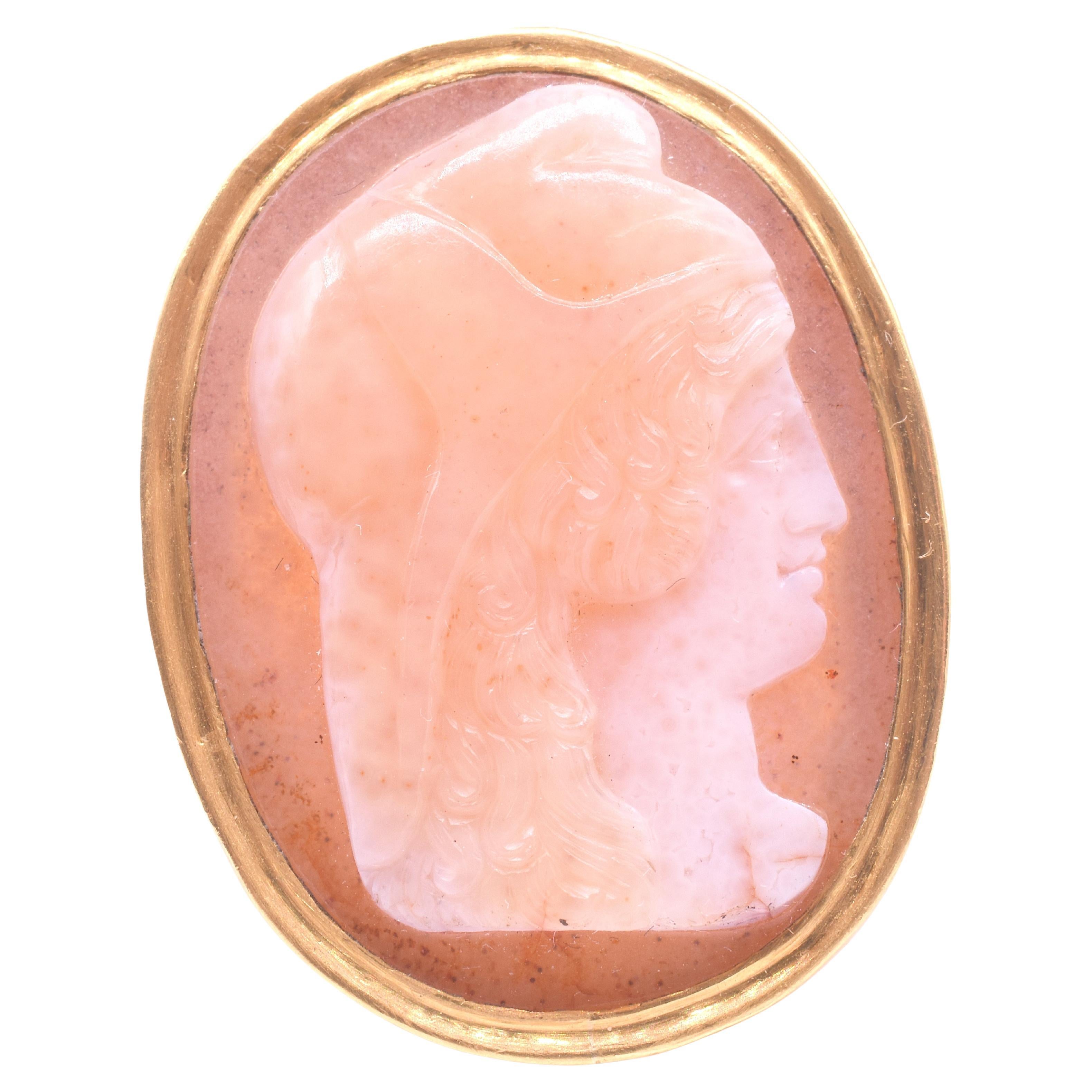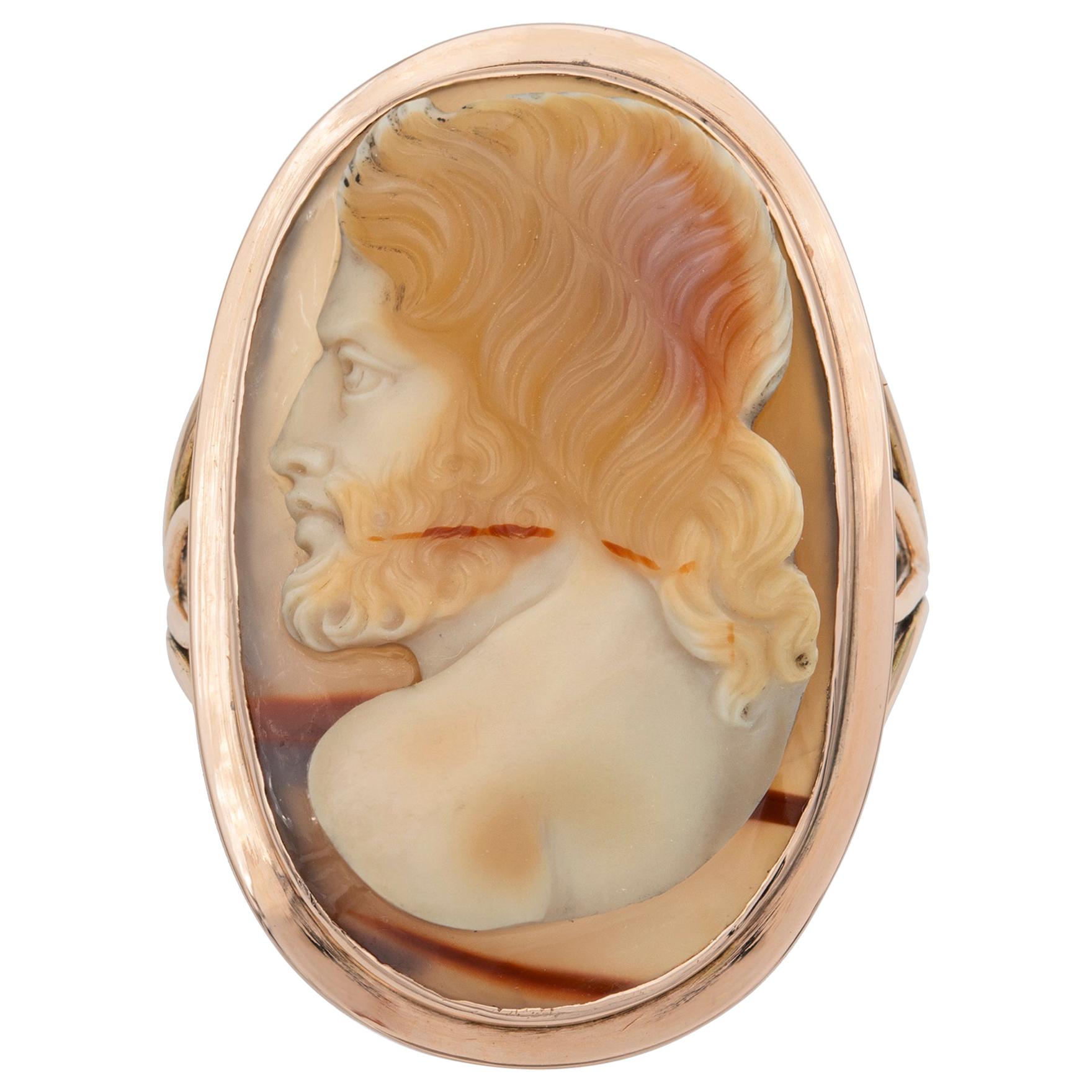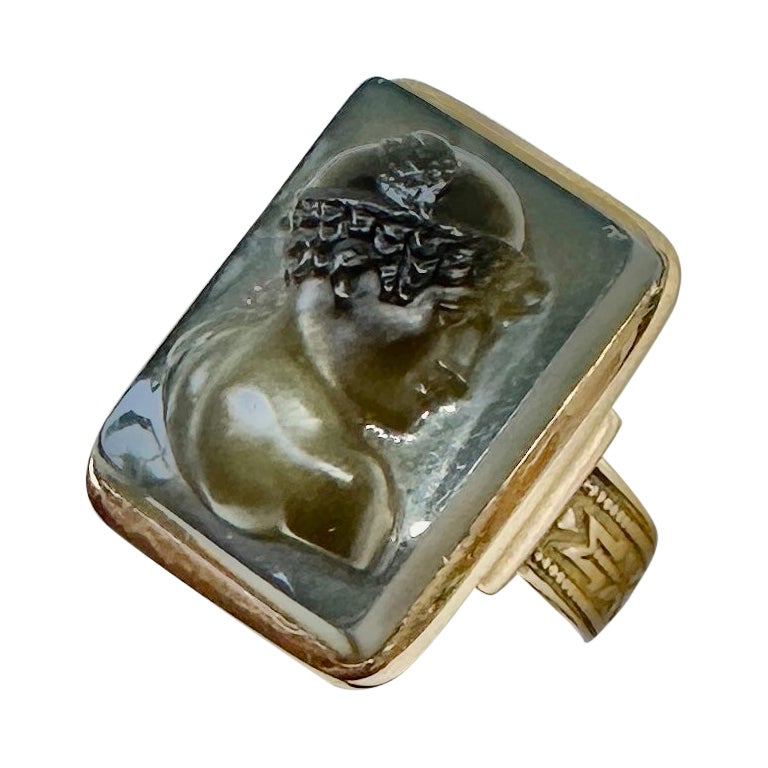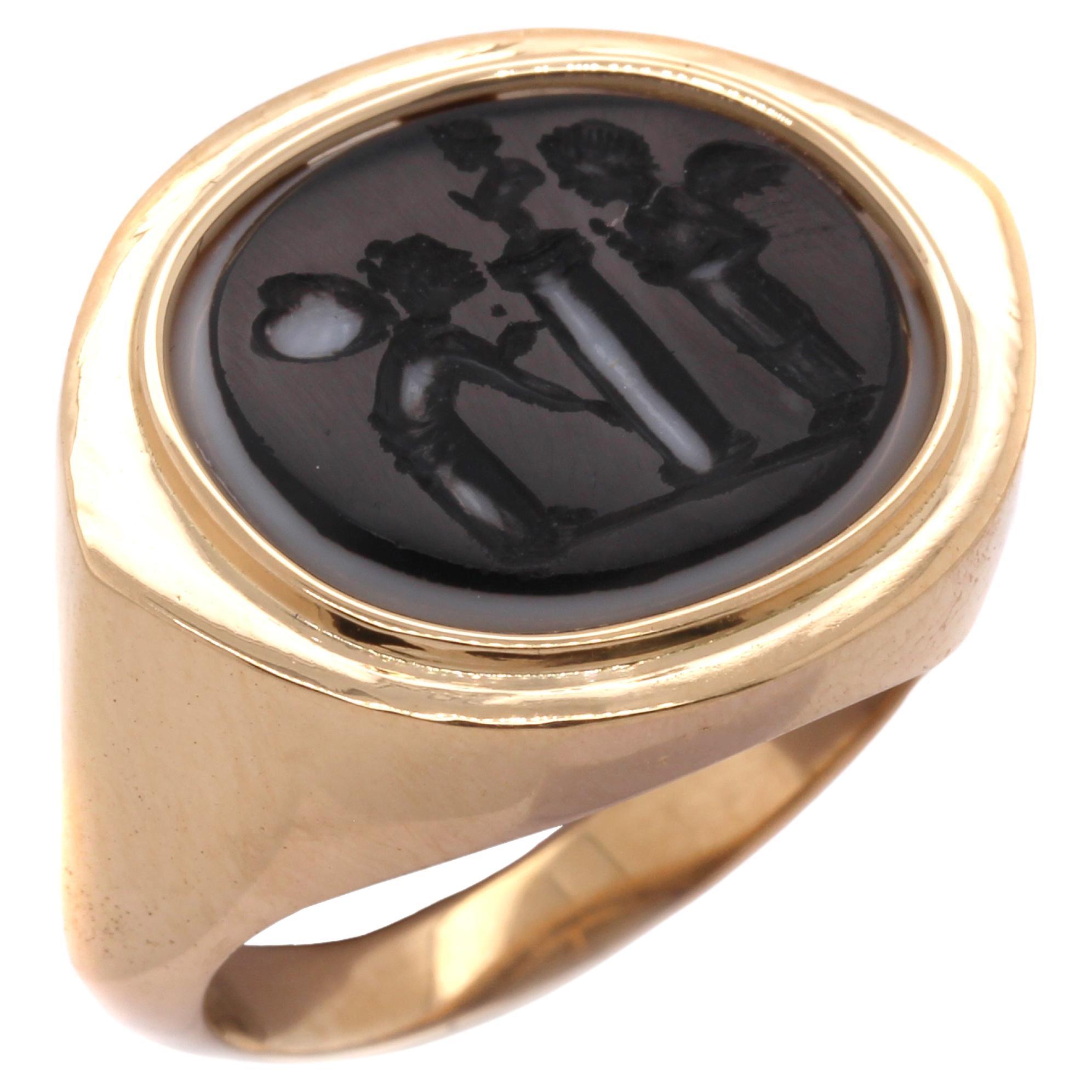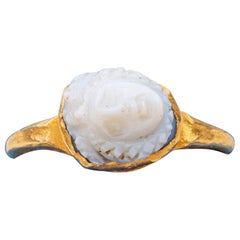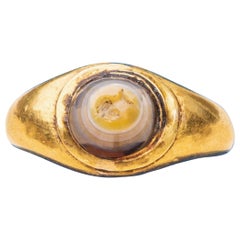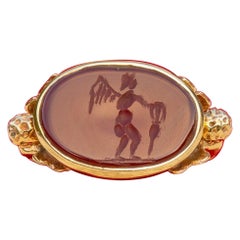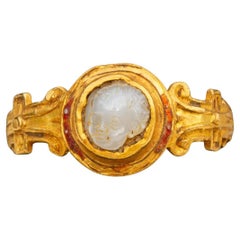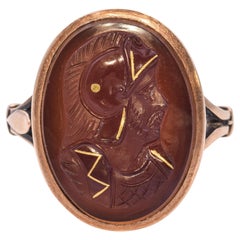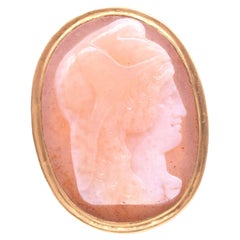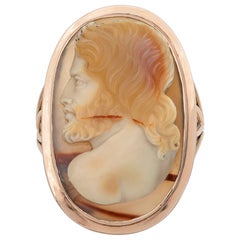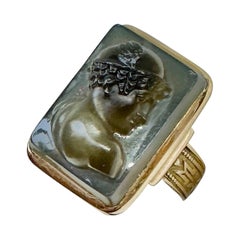Items Similar to Antique Gold Cameo Ring Greek Theatre Mask Silenus Hardstone Intaglio Signet
Video Loading
Want more images or videos?
Request additional images or videos from the seller
1 of 13
Antique Gold Cameo Ring Greek Theatre Mask Silenus Hardstone Intaglio Signet
$2,180.35
£1,600
€1,869.21
CA$2,994.77
A$3,348.52
CHF 1,756.44
MX$40,558.58
NOK 22,171.56
SEK 20,946.77
DKK 13,951.81
About the Item
A very unusual antique gold ring set with a carved brown and white hardstone cameo depicting the theatrical comic mask of Silenus, the Greek mythological old rustic god of wine-making and drunkenness. The ring was made in the late 19th century and carries French control marks for 18K gold, whilst the cameo is probably Italian and made slightly earlier, circa 1800.
Silenus was a companion to the wine god Dionysus, and suitably he was a notorious consumer of wine, usually drunk and supported by satyrs or carried by a donkey. Silenus was described as the oldest, wisest and most drunken of the followers of Dionysus, and was said to possess special knowledge and the power of prophecy when intoxicated. He presides over the other satyrs and is related to musical creativity, prophetic ecstasy, drunken joy and drunken dances.
Silenus was usually depicted as a jovial old man, bald yet bearded, with a pot-belly, thick lips and snub-nose. The masks worn to play him in theatre really emphasised these features, as you can see with this cameo carving
Theatre was a key part of ancient Greek culture. The theatrical masks worn by the actors, known as ‘prosopon’, served various purposes. They enabled individual actors to play multiple roles (or genders) in the same performance; the exaggerated expressions helped define the character being portrayed; they helped spectators in the back rows to tell the characters apart. This particular masked as mentioned before is a comedic Silenus, please see final photo for other examples of Silenus masks in museum collections.
UK size N 1/2, US size 7
4.84g 18K gold
French ‘tête d’aigle’ (eagle head) control mark indicates 18K gold. The cameo protrudes 5mm from the finger and measures 20mm x 15mm on its longest axes.
In overall good condition, there may have been a chip to the nose of the mask and some of the prongs have been glued to the stone for additional stability, see photos.
Resizing is available.
About the Seller
5.0
Vetted Professional Seller
Every seller passes strict standards for authenticity and reliability
Established in 2019
1stDibs seller since 2022
46 sales on 1stDibs
- ShippingRetrieving quote...Shipping from: London, United Kingdom
- Return Policy
Authenticity Guarantee
In the unlikely event there’s an issue with an item’s authenticity, contact us within 1 year for a full refund. DetailsMoney-Back Guarantee
If your item is not as described, is damaged in transit, or does not arrive, contact us within 7 days for a full refund. Details24-Hour Cancellation
You have a 24-hour grace period in which to reconsider your purchase, with no questions asked.Vetted Professional Sellers
Our world-class sellers must adhere to strict standards for service and quality, maintaining the integrity of our listings.Price-Match Guarantee
If you find that a seller listed the same item for a lower price elsewhere, we’ll match it.Trusted Global Delivery
Our best-in-class carrier network provides specialized shipping options worldwide, including custom delivery.More From This Seller
View AllSmall Ancient Roman Medusa Carved Cameo Gold Ring 2nd Century Gem Carving
Located in London, GB
A scarce and small ancient Roman gold Medusa cameo ring, circa 2nd to 3rd century AD.
The carved layered onyx gemstone is white in colour and depicts the bust of Medusa engraved wit...
Category
Antique 15th Century and Earlier Italian Classical Roman Signet Rings
Materials
Onyx, Gold
Ancient Roman Gold Mens Signet Ring Conical Intaglio Ring Gem Carving
Located in London, GB
A superb ancient Roman agate intaglio ring. The high-karat gold signet ring is set with an engraved gemstone, known as an ‘intaglio’. It dates from between the 2nd to 3rd century AD and is a fine example of a Romano-British intaglio.
The conical-shaped agate gemstone displays various bands of colour ranging from honey brown to greyish-blue. The engraving depicts the bust of a man wearing a helmet, possibly winged which would depict Mercury, the Roman god of commerce, financial gain and communication. In Roman times, people would wear rings with the intaglio of Mercury in hope that the he would protect them and bless them with good financial fortune in their lives.
A number of referenced examples of similar ancient Roman conical shaped intaglios reside in notable museums all across the world, from the British Museum to the Louvre. A page with these examples and their sources can be found in the final photos of the listing. Similar examples can also be found in the extensive Alice and Louis Koch collection (items: 234, 235, 241, 301). Again see final images for reference.
The gold ring mount is of D-shaped cross-section and a hollow 22K gold construction. The ring has a fantastic smooth silk-like texture when worn. It remains in good overall condition and the intaglio is very secure in the mount. The gold mount dates to the late 18th to early 19th century, and the shape is inspired by ancient Roman ring...
Category
Antique 15th Century and Earlier Signet Rings
Materials
Agate, 22k Gold
Antique Gold Engraved Carnelian Cherub Eros Intaglio Ring Signet Ring
Located in London, GB
A striking gold ring, dating from the early 20th century. The figural shoulders are adorned with angelic putti motifs, delicately sculpted to depict Eros, the Greek God of love and d...
Category
Early 20th Century Classical Roman Engagement Rings
Materials
9k Gold
Rare Elizabethan 16th Century Gold Cupid Ring Renaissance Gold Ring Womens
Located in London, GB
This exquisite Elizabethan gold ring dates to the mid-16th century (c.1570) and features a circular bezel set with a high-relief cameo of Cupid, delicately carved in white chalcedony...
Category
Antique 16th Century Italian Renaissance Engagement Rings
Materials
Chalcedony, 22k Gold
Georgian 18th Century Signet Ring with Ancient Roman Nicolo Intaglio of Hercules
Located in London, GB
A superb ancient Roman nicolo intaglio set in a late 18th century gold signet ring. Nicolo intaglios are a particular type of intaglio ma...
Category
Antique Late 18th Century English Georgian Signet Rings
Ancient Gold Amethyst Engraved Scorpion Ring Early Javanese Intaglio Ring
Located in London, GB
This scarce gold intaglio ring dates to the Indonesian Classical period, circa 8th–10th century.
The ring is crafted from high-karat gold (22K), featuring a circular bezel that holds an amethyst gemstone engraved with a scorpion motif. Scorpions were often considered symbols of protection in ancient traditions, aligning with Javanese beliefs that rings possessed magical properties to bring good fortune and guard against harm.
The stirrup-shaped shoulders, designed to mimic the form of water buffalo horns, are a hallmark of early Javanese craftsmanship. This distinctive design reflects both artistic expression and cultural symbolism rooted in Java’s agricultural and spiritual traditions.
Java, one of Indonesia’s largest islands, was a significant centre of civilisation and artistry during this period. Gold rings were not merely decorative but also served as currency, payment for fines, dowries, and even wedding feasts. Imported gemstones, like the present amethyst, were chosen for their astrological, magical, and medicinal properties, further enhancing their importance in Javanese society.
Referenced Examples:
Similar rings can be found in the Metropolitan Museum of Art (Accession No. 1998.544.298).
Additional examples are catalogued in Java Gold...
Category
Antique 15th Century and Earlier Engagement Rings
Materials
Amethyst, 22k Gold
You May Also Like
Antique Victorian Rose Gold Sard Intaglio Soldier Cameo Ring
Located in New York, NY
Antique Victorian Gold Intaglio Ring. Crafted in gold with a warm rose gold hue, this Victorian-era ring features a striking red sard stone, intricately carved with a detailed intagl...
Category
Antique 19th Century Victorian Engagement Rings
Materials
Chalcedony, Gold, Rose Gold
C1800 18K Neoclassical Hard-stone Cameo of Greek Hero Perseus in
Located in Baltimore, MD
Georgian hard stone cameo ring with a an oval shaped cameo depicting the profile of the hero Perseus, who rescued Andromeda & slew Medusa. The ring is a copied from the sculpture by ...
Category
Antique Early 19th Century Italian Georgian Fashion Rings
Materials
18k Gold
Georgian Hardstone Cameo Ring
Located in London, GB
A Georgian hardstone cameo ring, the oval-shaped layered agate cameo, measuring approximately 27 by 17mm, and depicting the finely carved profile ...
Category
Antique Late 18th Century British George III Fashion Rings
Materials
Agate, Rose Gold
Hermes Mercury Hardstone Cameo Ring Classic Victorian Agate Gold Deeply Carved
Located in New York, NY
Indulge in a superb museum quality Victorian - Belle Epoque deeply carved hardstone Cameo Ring depicting an image of the god Hermes or Mercury in a spectacular high relief carved agate and set in a beautiful and elegant Etruscan Revival setting in 10 Karat Gold. The ring dates to circa 1850-1880. The agate is a stunningly beautiful color. The ring features the most beautifully carved high relief cameo of the Greek God Hermes, known as Mercury to the Romans, with his fabulous face with his winged helmet. His face is an exquisite rendition in the hardstone of the handsome god with his curly hair, elegant face, winged helmet, and wonderful neck and shoulders. I love the way the artist has created his nude form in the cameo. The carving is very deep 3-dimensional design attesting to the extremely fine quality of the work. The setting is beautiful with the repousse adornment of the band in the Etruscan Revival style.
Antique hand carved cameo...
Category
Antique 19th Century Unknown Victorian Cocktail Rings
Materials
Agate, Gold, Yellow Gold, 10k Gold
Castellani Ancient Roman Agate Intaglio Gold Ring
By Castellani
Located in New York, NY
Castellani® has selected this Ancient Roman Agate Intaglio for the "Cleopatra" Ring Setting.
The intaglio dates to the 3rd to 7th Century.
The intaglio is both black and white agate, which is a hard stone and very good for carving. The agate has two layers of color, black on the top and white at the bottom. The agate intaglio is solid and is one piece. The carver was able to use these two color layers to give dimension and detail. The Column and Angel on the left wings are white and the balance is all black. The Carver knew the material he/she was carving and used this to create this very unique scene.
The intaglio shows two angels standing on either side of a column/pillar looking at the bust of a man on top of the pillar.
The angels are female and male. The bust on the pedestal is of a male.
The intaglio is set below the frame. The frame flairs out to a subtle point on the sides and has a flat surface.
The "Cleopatra" ring design was a style that Castellani created in the 1860's and was inspired by Ancient Roman rings...
Category
21st Century and Contemporary American Etruscan Revival Signet Rings
Materials
Agate, 18k Gold, Gold
Georgian Socrate Agate Cameo Ring 18 KT Gold
Located in Napoli, IT
Ancient Cameo Art
A beautiful Georgian period ring hand crafted of solid 18 KT gold
Featuring a face right profile of Socrate skilfully carved from Agate...
Category
Antique Early 19th Century European Georgian Signet Rings
Materials
Agate, Gold, 18k Gold
More Ways To Browse
Jewelry Mask
Intaglio Cameo
Old Cameo Jewelry
Italian Hardstone
Old Cameos
18k Signet Greek Ring
Italian Ring Intaglio
Antique French Signet Ring
Antique Hardstone Ring
Hardstone Cameo Ring
Antique Greece Pot
Intaglio Ring White
Georgian Cameo Ring
Satyr Ring
Antique D Signet Ring
Hardstone Intaglio
Intaglio Ring Georgian
Dionysus Cameo
